Corporate Accounting Assignment (BO1COAC318): Fair Value & Impairment
VerifiedAdded on 2022/11/17
|12
|2858
|74
Report
AI Summary
This report presents a comprehensive analysis of corporate accounting, addressing fair value measurement and impairment calculations. Part A delves into the concept of fair value measurement, discussing its definition, the relevant accounting standard (AASB 13), its necessity, and practical implementation, including aspects like valuation techniques and disclosure requirements. Part B focuses on impairment calculations, specifically for Gali Limited, including journal entries recorded for loss on impairment as of June 30, 2015. The report provides detailed calculations and explanations, offering insights into the application of accounting standards in real-world scenarios. It serves as a valuable resource for students studying corporate accounting, offering a practical understanding of key concepts and their application.

Paraphrase This Document
Need a fresh take? Get an instant paraphrase of this document with our AI Paraphraser
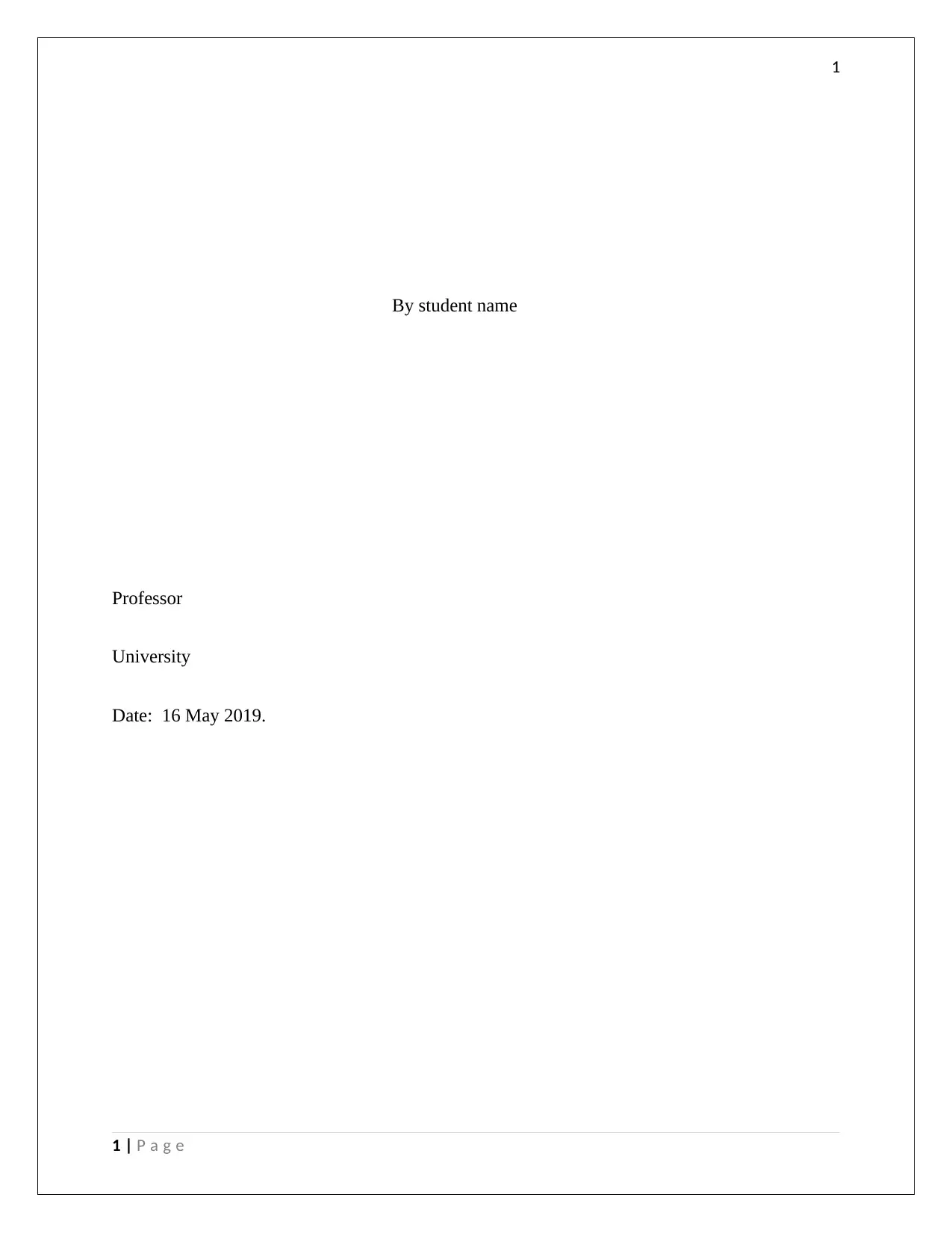
1
By student name
Professor
University
Date: 16 May 2019.
1 | P a g e
By student name
Professor
University
Date: 16 May 2019.
1 | P a g e
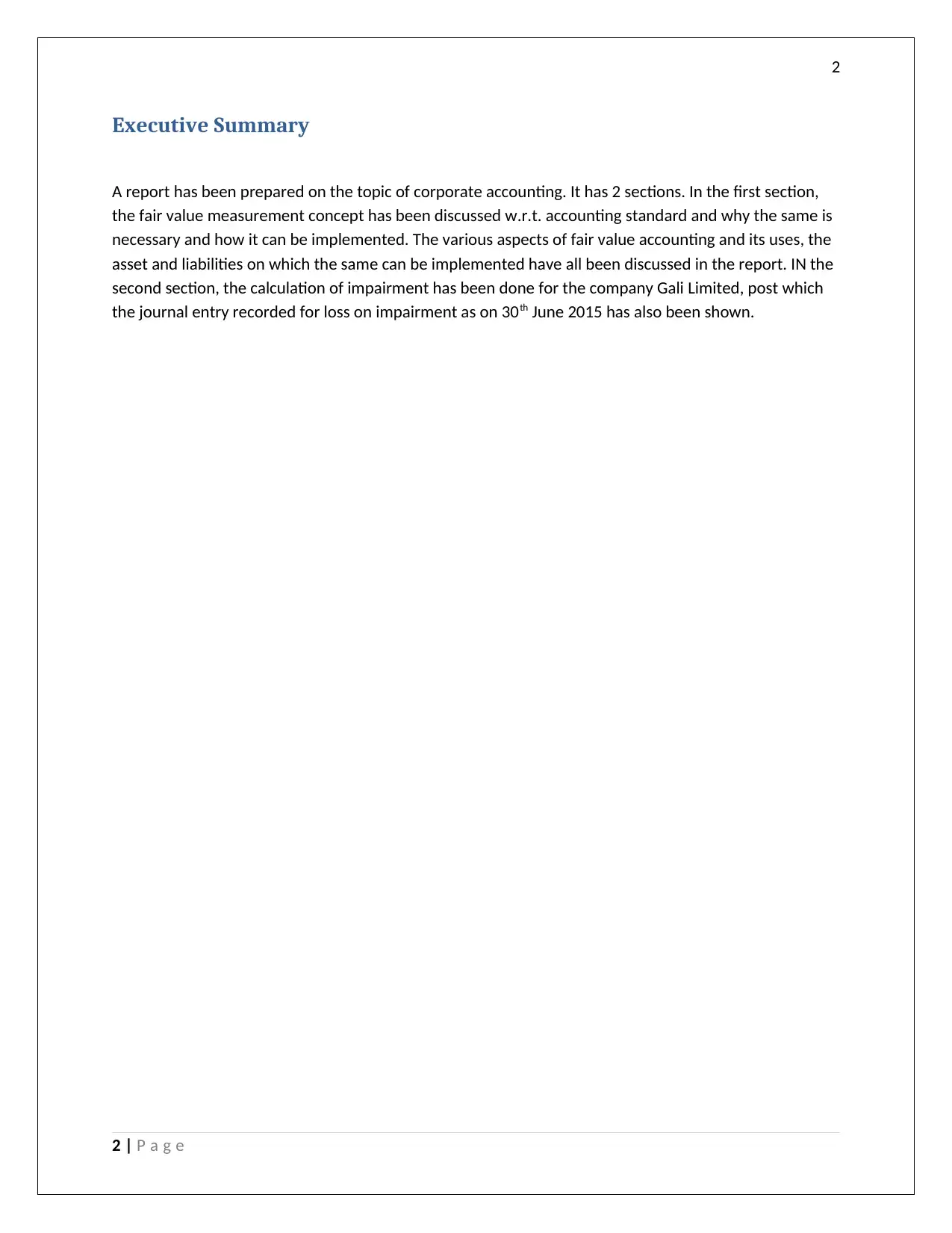
2
Executive Summary
A report has been prepared on the topic of corporate accounting. It has 2 sections. In the first section,
the fair value measurement concept has been discussed w.r.t. accounting standard and why the same is
necessary and how it can be implemented. The various aspects of fair value accounting and its uses, the
asset and liabilities on which the same can be implemented have all been discussed in the report. IN the
second section, the calculation of impairment has been done for the company Gali Limited, post which
the journal entry recorded for loss on impairment as on 30th June 2015 has also been shown.
2 | P a g e
Executive Summary
A report has been prepared on the topic of corporate accounting. It has 2 sections. In the first section,
the fair value measurement concept has been discussed w.r.t. accounting standard and why the same is
necessary and how it can be implemented. The various aspects of fair value accounting and its uses, the
asset and liabilities on which the same can be implemented have all been discussed in the report. IN the
second section, the calculation of impairment has been done for the company Gali Limited, post which
the journal entry recorded for loss on impairment as on 30th June 2015 has also been shown.
2 | P a g e
⊘ This is a preview!⊘
Do you want full access?
Subscribe today to unlock all pages.

Trusted by 1+ million students worldwide
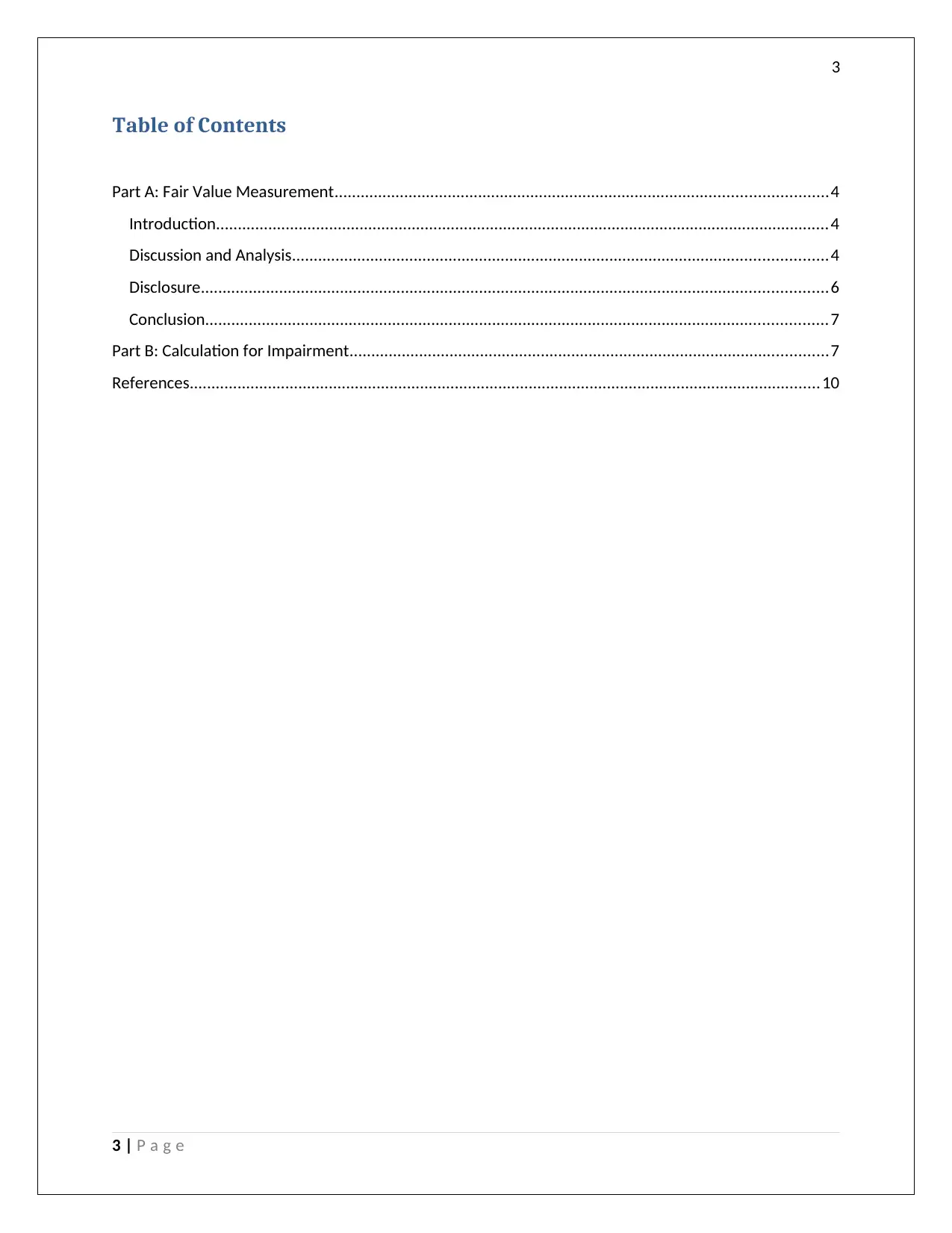
3
Table of Contents
Part A: Fair Value Measurement.................................................................................................................4
Introduction.............................................................................................................................................4
Discussion and Analysis...........................................................................................................................4
Disclosure................................................................................................................................................6
Conclusion...............................................................................................................................................7
Part B: Calculation for Impairment..............................................................................................................7
References.................................................................................................................................................10
3 | P a g e
Table of Contents
Part A: Fair Value Measurement.................................................................................................................4
Introduction.............................................................................................................................................4
Discussion and Analysis...........................................................................................................................4
Disclosure................................................................................................................................................6
Conclusion...............................................................................................................................................7
Part B: Calculation for Impairment..............................................................................................................7
References.................................................................................................................................................10
3 | P a g e
Paraphrase This Document
Need a fresh take? Get an instant paraphrase of this document with our AI Paraphraser
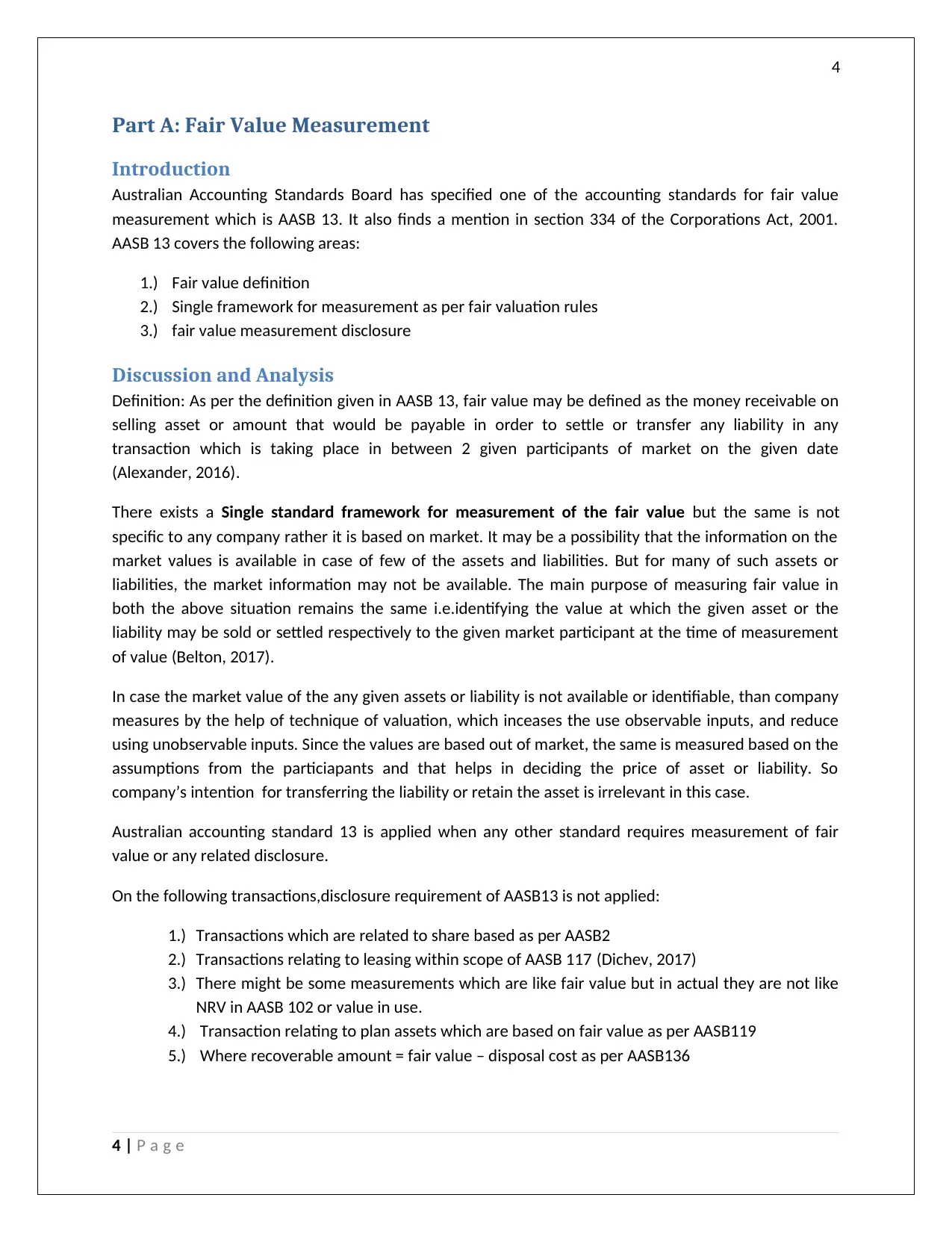
4
Part A: Fair Value Measurement
Introduction
Australian Accounting Standards Board has specified one of the accounting standards for fair value
measurement which is AASB 13. It also finds a mention in section 334 of the Corporations Act, 2001.
AASB 13 covers the following areas:
1.) Fair value definition
2.) Single framework for measurement as per fair valuation rules
3.) fair value measurement disclosure
Discussion and Analysis
Definition: As per the definition given in AASB 13, fair value may be defined as the money receivable on
selling asset or amount that would be payable in order to settle or transfer any liability in any
transaction which is taking place in between 2 given participants of market on the given date
(Alexander, 2016).
There exists a Single standard framework for measurement of the fair value but the same is not
specific to any company rather it is based on market. It may be a possibility that the information on the
market values is available in case of few of the assets and liabilities. But for many of such assets or
liabilities, the market information may not be available. The main purpose of measuring fair value in
both the above situation remains the same i.e.identifying the value at which the given asset or the
liability may be sold or settled respectively to the given market participant at the time of measurement
of value (Belton, 2017).
In case the market value of the any given assets or liability is not available or identifiable, than company
measures by the help of technique of valuation, which inceases the use observable inputs, and reduce
using unobservable inputs. Since the values are based out of market, the same is measured based on the
assumptions from the particiapants and that helps in deciding the price of asset or liability. So
company’s intention for transferring the liability or retain the asset is irrelevant in this case.
Australian accounting standard 13 is applied when any other standard requires measurement of fair
value or any related disclosure.
On the following transactions,disclosure requirement of AASB13 is not applied:
1.) Transactions which are related to share based as per AASB2
2.) Transactions relating to leasing within scope of AASB 117 (Dichev, 2017)
3.) There might be some measurements which are like fair value but in actual they are not like
NRV in AASB 102 or value in use.
4.) Transaction relating to plan assets which are based on fair value as per AASB119
5.) Where recoverable amount = fair value – disposal cost as per AASB136
4 | P a g e
Part A: Fair Value Measurement
Introduction
Australian Accounting Standards Board has specified one of the accounting standards for fair value
measurement which is AASB 13. It also finds a mention in section 334 of the Corporations Act, 2001.
AASB 13 covers the following areas:
1.) Fair value definition
2.) Single framework for measurement as per fair valuation rules
3.) fair value measurement disclosure
Discussion and Analysis
Definition: As per the definition given in AASB 13, fair value may be defined as the money receivable on
selling asset or amount that would be payable in order to settle or transfer any liability in any
transaction which is taking place in between 2 given participants of market on the given date
(Alexander, 2016).
There exists a Single standard framework for measurement of the fair value but the same is not
specific to any company rather it is based on market. It may be a possibility that the information on the
market values is available in case of few of the assets and liabilities. But for many of such assets or
liabilities, the market information may not be available. The main purpose of measuring fair value in
both the above situation remains the same i.e.identifying the value at which the given asset or the
liability may be sold or settled respectively to the given market participant at the time of measurement
of value (Belton, 2017).
In case the market value of the any given assets or liability is not available or identifiable, than company
measures by the help of technique of valuation, which inceases the use observable inputs, and reduce
using unobservable inputs. Since the values are based out of market, the same is measured based on the
assumptions from the particiapants and that helps in deciding the price of asset or liability. So
company’s intention for transferring the liability or retain the asset is irrelevant in this case.
Australian accounting standard 13 is applied when any other standard requires measurement of fair
value or any related disclosure.
On the following transactions,disclosure requirement of AASB13 is not applied:
1.) Transactions which are related to share based as per AASB2
2.) Transactions relating to leasing within scope of AASB 117 (Dichev, 2017)
3.) There might be some measurements which are like fair value but in actual they are not like
NRV in AASB 102 or value in use.
4.) Transaction relating to plan assets which are based on fair value as per AASB119
5.) Where recoverable amount = fair value – disposal cost as per AASB136
4 | P a g e
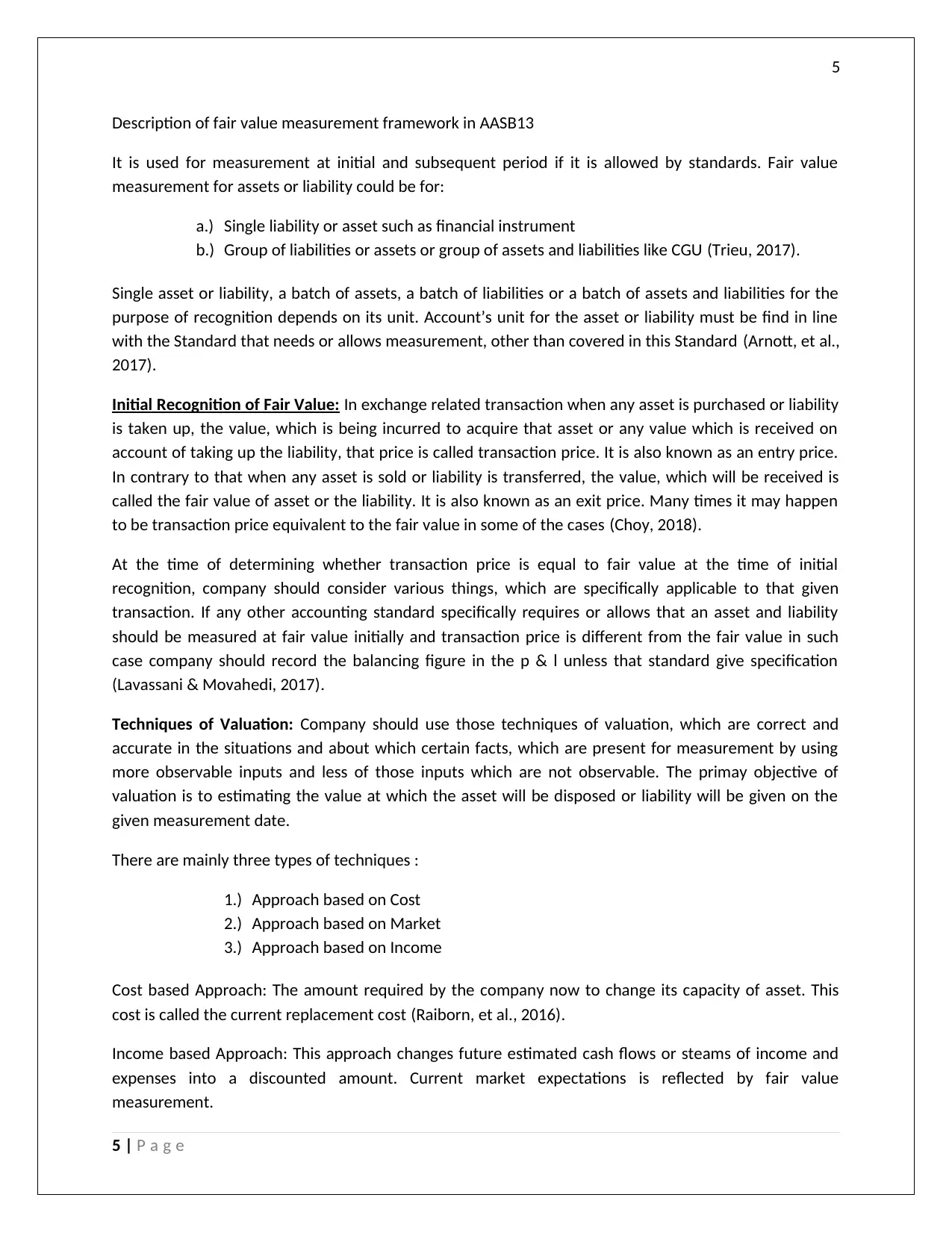
5
Description of fair value measurement framework in AASB13
It is used for measurement at initial and subsequent period if it is allowed by standards. Fair value
measurement for assets or liability could be for:
a.) Single liability or asset such as financial instrument
b.) Group of liabilities or assets or group of assets and liabilities like CGU (Trieu, 2017).
Single asset or liability, a batch of assets, a batch of liabilities or a batch of assets and liabilities for the
purpose of recognition depends on its unit. Account’s unit for the asset or liability must be find in line
with the Standard that needs or allows measurement, other than covered in this Standard (Arnott, et al.,
2017).
Initial Recognition of Fair Value: In exchange related transaction when any asset is purchased or liability
is taken up, the value, which is being incurred to acquire that asset or any value which is received on
account of taking up the liability, that price is called transaction price. It is also known as an entry price.
In contrary to that when any asset is sold or liability is transferred, the value, which will be received is
called the fair value of asset or the liability. It is also known as an exit price. Many times it may happen
to be transaction price equivalent to the fair value in some of the cases (Choy, 2018).
At the time of determining whether transaction price is equal to fair value at the time of initial
recognition, company should consider various things, which are specifically applicable to that given
transaction. If any other accounting standard specifically requires or allows that an asset and liability
should be measured at fair value initially and transaction price is different from the fair value in such
case company should record the balancing figure in the p & l unless that standard give specification
(Lavassani & Movahedi, 2017).
Techniques of Valuation: Company should use those techniques of valuation, which are correct and
accurate in the situations and about which certain facts, which are present for measurement by using
more observable inputs and less of those inputs which are not observable. The primay objective of
valuation is to estimating the value at which the asset will be disposed or liability will be given on the
given measurement date.
There are mainly three types of techniques :
1.) Approach based on Cost
2.) Approach based on Market
3.) Approach based on Income
Cost based Approach: The amount required by the company now to change its capacity of asset. This
cost is called the current replacement cost (Raiborn, et al., 2016).
Income based Approach: This approach changes future estimated cash flows or steams of income and
expenses into a discounted amount. Current market expectations is reflected by fair value
measurement.
5 | P a g e
Description of fair value measurement framework in AASB13
It is used for measurement at initial and subsequent period if it is allowed by standards. Fair value
measurement for assets or liability could be for:
a.) Single liability or asset such as financial instrument
b.) Group of liabilities or assets or group of assets and liabilities like CGU (Trieu, 2017).
Single asset or liability, a batch of assets, a batch of liabilities or a batch of assets and liabilities for the
purpose of recognition depends on its unit. Account’s unit for the asset or liability must be find in line
with the Standard that needs or allows measurement, other than covered in this Standard (Arnott, et al.,
2017).
Initial Recognition of Fair Value: In exchange related transaction when any asset is purchased or liability
is taken up, the value, which is being incurred to acquire that asset or any value which is received on
account of taking up the liability, that price is called transaction price. It is also known as an entry price.
In contrary to that when any asset is sold or liability is transferred, the value, which will be received is
called the fair value of asset or the liability. It is also known as an exit price. Many times it may happen
to be transaction price equivalent to the fair value in some of the cases (Choy, 2018).
At the time of determining whether transaction price is equal to fair value at the time of initial
recognition, company should consider various things, which are specifically applicable to that given
transaction. If any other accounting standard specifically requires or allows that an asset and liability
should be measured at fair value initially and transaction price is different from the fair value in such
case company should record the balancing figure in the p & l unless that standard give specification
(Lavassani & Movahedi, 2017).
Techniques of Valuation: Company should use those techniques of valuation, which are correct and
accurate in the situations and about which certain facts, which are present for measurement by using
more observable inputs and less of those inputs which are not observable. The primay objective of
valuation is to estimating the value at which the asset will be disposed or liability will be given on the
given measurement date.
There are mainly three types of techniques :
1.) Approach based on Cost
2.) Approach based on Market
3.) Approach based on Income
Cost based Approach: The amount required by the company now to change its capacity of asset. This
cost is called the current replacement cost (Raiborn, et al., 2016).
Income based Approach: This approach changes future estimated cash flows or steams of income and
expenses into a discounted amount. Current market expectations is reflected by fair value
measurement.
5 | P a g e
⊘ This is a preview!⊘
Do you want full access?
Subscribe today to unlock all pages.

Trusted by 1+ million students worldwide
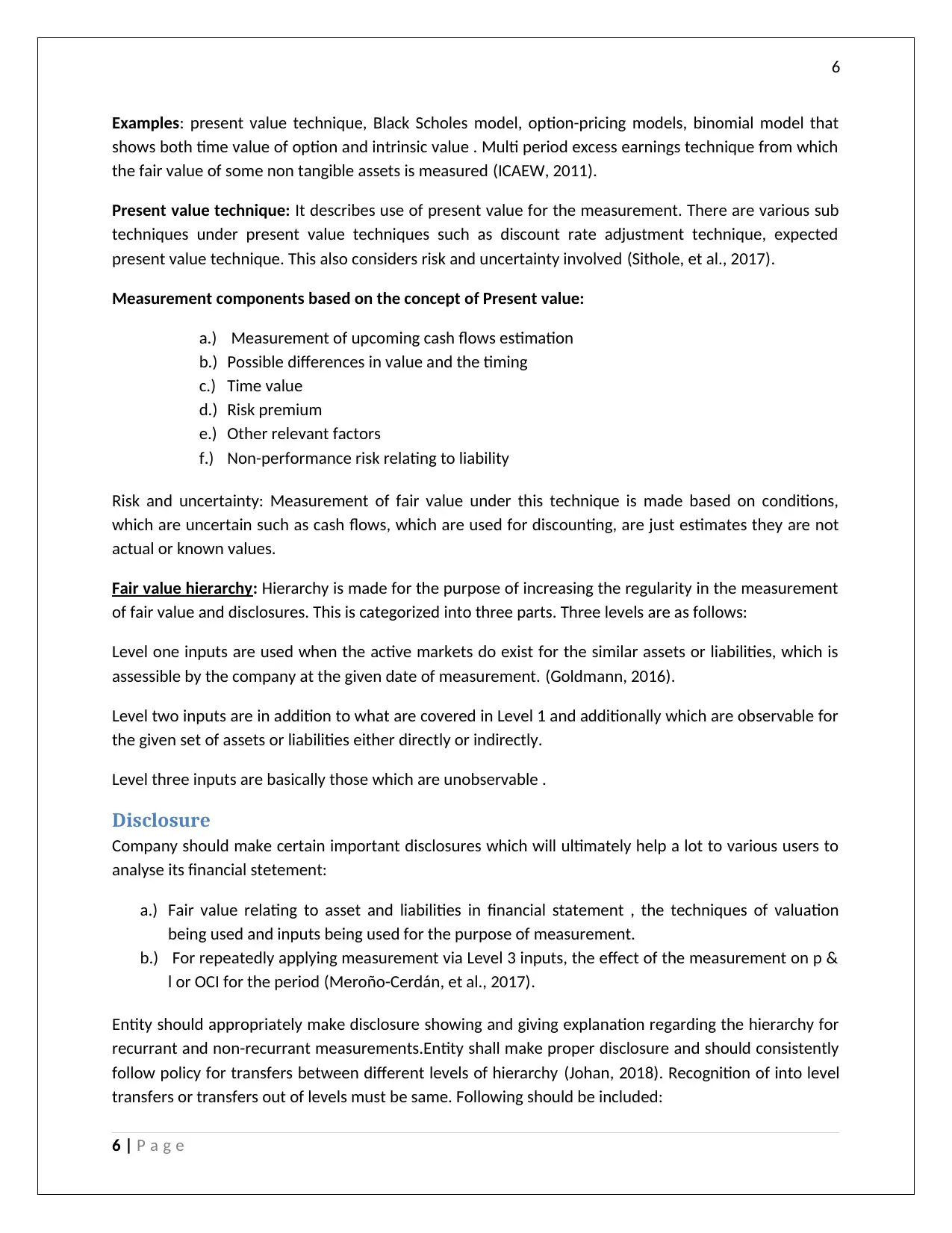
6
Examples: present value technique, Black Scholes model, option-pricing models, binomial model that
shows both time value of option and intrinsic value . Multi period excess earnings technique from which
the fair value of some non tangible assets is measured (ICAEW, 2011).
Present value technique: It describes use of present value for the measurement. There are various sub
techniques under present value techniques such as discount rate adjustment technique, expected
present value technique. This also considers risk and uncertainty involved (Sithole, et al., 2017).
Measurement components based on the concept of Present value:
a.) Measurement of upcoming cash flows estimation
b.) Possible differences in value and the timing
c.) Time value
d.) Risk premium
e.) Other relevant factors
f.) Non-performance risk relating to liability
Risk and uncertainty: Measurement of fair value under this technique is made based on conditions,
which are uncertain such as cash flows, which are used for discounting, are just estimates they are not
actual or known values.
Fair value hierarchy: Hierarchy is made for the purpose of increasing the regularity in the measurement
of fair value and disclosures. This is categorized into three parts. Three levels are as follows:
Level one inputs are used when the active markets do exist for the similar assets or liabilities, which is
assessible by the company at the given date of measurement. (Goldmann, 2016).
Level two inputs are in addition to what are covered in Level 1 and additionally which are observable for
the given set of assets or liabilities either directly or indirectly.
Level three inputs are basically those which are unobservable .
Disclosure
Company should make certain important disclosures which will ultimately help a lot to various users to
analyse its financial stetement:
a.) Fair value relating to asset and liabilities in financial statement , the techniques of valuation
being used and inputs being used for the purpose of measurement.
b.) For repeatedly applying measurement via Level 3 inputs, the effect of the measurement on p &
l or OCI for the period (Meroño-Cerdán, et al., 2017).
Entity should appropriately make disclosure showing and giving explanation regarding the hierarchy for
recurrant and non-recurrant measurements.Entity shall make proper disclosure and should consistently
follow policy for transfers between different levels of hierarchy (Johan, 2018). Recognition of into level
transfers or transfers out of levels must be same. Following should be included:
6 | P a g e
Examples: present value technique, Black Scholes model, option-pricing models, binomial model that
shows both time value of option and intrinsic value . Multi period excess earnings technique from which
the fair value of some non tangible assets is measured (ICAEW, 2011).
Present value technique: It describes use of present value for the measurement. There are various sub
techniques under present value techniques such as discount rate adjustment technique, expected
present value technique. This also considers risk and uncertainty involved (Sithole, et al., 2017).
Measurement components based on the concept of Present value:
a.) Measurement of upcoming cash flows estimation
b.) Possible differences in value and the timing
c.) Time value
d.) Risk premium
e.) Other relevant factors
f.) Non-performance risk relating to liability
Risk and uncertainty: Measurement of fair value under this technique is made based on conditions,
which are uncertain such as cash flows, which are used for discounting, are just estimates they are not
actual or known values.
Fair value hierarchy: Hierarchy is made for the purpose of increasing the regularity in the measurement
of fair value and disclosures. This is categorized into three parts. Three levels are as follows:
Level one inputs are used when the active markets do exist for the similar assets or liabilities, which is
assessible by the company at the given date of measurement. (Goldmann, 2016).
Level two inputs are in addition to what are covered in Level 1 and additionally which are observable for
the given set of assets or liabilities either directly or indirectly.
Level three inputs are basically those which are unobservable .
Disclosure
Company should make certain important disclosures which will ultimately help a lot to various users to
analyse its financial stetement:
a.) Fair value relating to asset and liabilities in financial statement , the techniques of valuation
being used and inputs being used for the purpose of measurement.
b.) For repeatedly applying measurement via Level 3 inputs, the effect of the measurement on p &
l or OCI for the period (Meroño-Cerdán, et al., 2017).
Entity should appropriately make disclosure showing and giving explanation regarding the hierarchy for
recurrant and non-recurrant measurements.Entity shall make proper disclosure and should consistently
follow policy for transfers between different levels of hierarchy (Johan, 2018). Recognition of into level
transfers or transfers out of levels must be same. Following should be included:
6 | P a g e
Paraphrase This Document
Need a fresh take? Get an instant paraphrase of this document with our AI Paraphraser
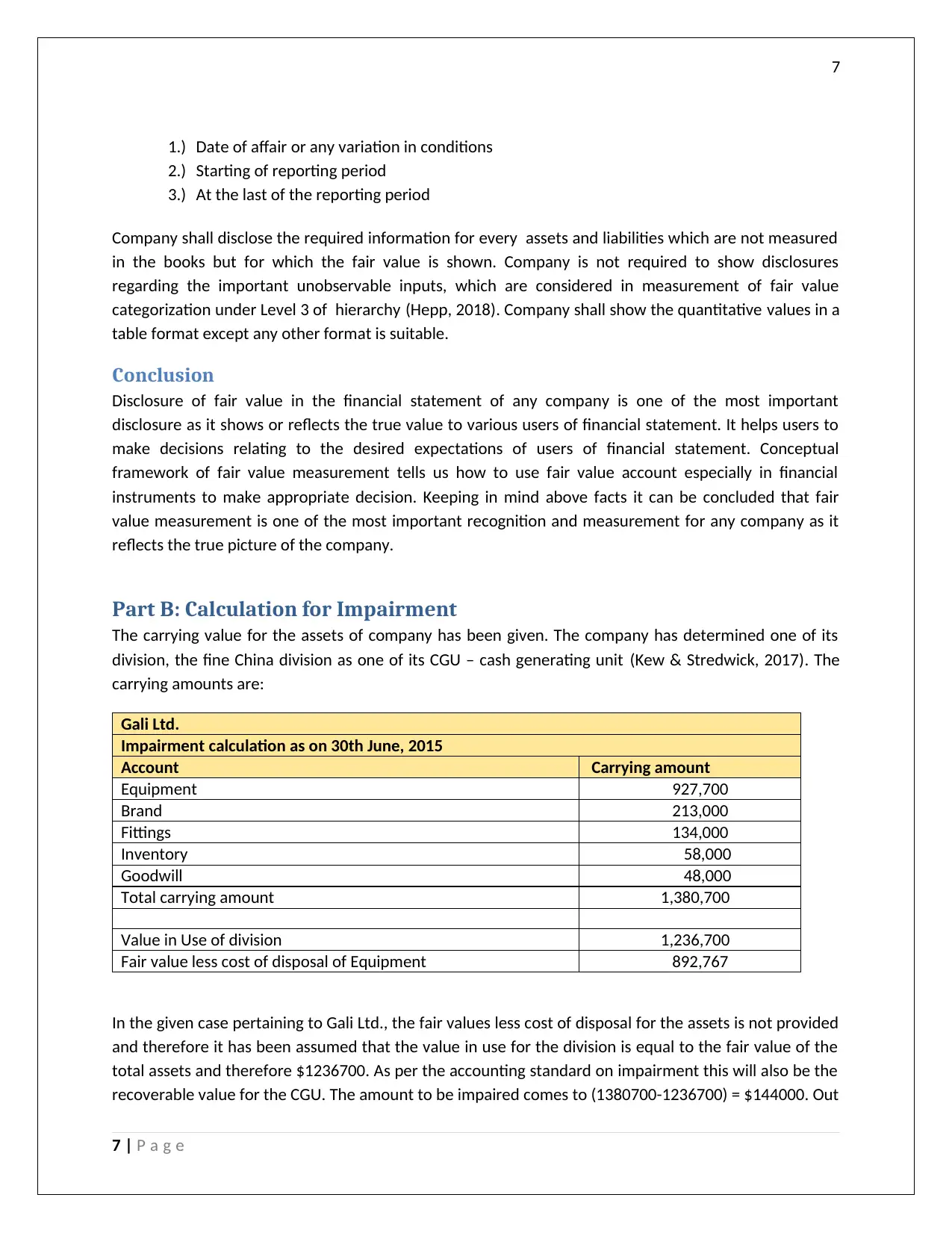
7
1.) Date of affair or any variation in conditions
2.) Starting of reporting period
3.) At the last of the reporting period
Company shall disclose the required information for every assets and liabilities which are not measured
in the books but for which the fair value is shown. Company is not required to show disclosures
regarding the important unobservable inputs, which are considered in measurement of fair value
categorization under Level 3 of hierarchy (Hepp, 2018). Company shall show the quantitative values in a
table format except any other format is suitable.
Conclusion
Disclosure of fair value in the financial statement of any company is one of the most important
disclosure as it shows or reflects the true value to various users of financial statement. It helps users to
make decisions relating to the desired expectations of users of financial statement. Conceptual
framework of fair value measurement tells us how to use fair value account especially in financial
instruments to make appropriate decision. Keeping in mind above facts it can be concluded that fair
value measurement is one of the most important recognition and measurement for any company as it
reflects the true picture of the company.
Part B: Calculation for Impairment
The carrying value for the assets of company has been given. The company has determined one of its
division, the fine China division as one of its CGU – cash generating unit (Kew & Stredwick, 2017). The
carrying amounts are:
Gali Ltd.
Impairment calculation as on 30th June, 2015
Account Carrying amount
Equipment 927,700
Brand 213,000
Fittings 134,000
Inventory 58,000
Goodwill 48,000
Total carrying amount 1,380,700
Value in Use of division 1,236,700
Fair value less cost of disposal of Equipment 892,767
In the given case pertaining to Gali Ltd., the fair values less cost of disposal for the assets is not provided
and therefore it has been assumed that the value in use for the division is equal to the fair value of the
total assets and therefore $1236700. As per the accounting standard on impairment this will also be the
recoverable value for the CGU. The amount to be impaired comes to (1380700-1236700) = $144000. Out
7 | P a g e
1.) Date of affair or any variation in conditions
2.) Starting of reporting period
3.) At the last of the reporting period
Company shall disclose the required information for every assets and liabilities which are not measured
in the books but for which the fair value is shown. Company is not required to show disclosures
regarding the important unobservable inputs, which are considered in measurement of fair value
categorization under Level 3 of hierarchy (Hepp, 2018). Company shall show the quantitative values in a
table format except any other format is suitable.
Conclusion
Disclosure of fair value in the financial statement of any company is one of the most important
disclosure as it shows or reflects the true value to various users of financial statement. It helps users to
make decisions relating to the desired expectations of users of financial statement. Conceptual
framework of fair value measurement tells us how to use fair value account especially in financial
instruments to make appropriate decision. Keeping in mind above facts it can be concluded that fair
value measurement is one of the most important recognition and measurement for any company as it
reflects the true picture of the company.
Part B: Calculation for Impairment
The carrying value for the assets of company has been given. The company has determined one of its
division, the fine China division as one of its CGU – cash generating unit (Kew & Stredwick, 2017). The
carrying amounts are:
Gali Ltd.
Impairment calculation as on 30th June, 2015
Account Carrying amount
Equipment 927,700
Brand 213,000
Fittings 134,000
Inventory 58,000
Goodwill 48,000
Total carrying amount 1,380,700
Value in Use of division 1,236,700
Fair value less cost of disposal of Equipment 892,767
In the given case pertaining to Gali Ltd., the fair values less cost of disposal for the assets is not provided
and therefore it has been assumed that the value in use for the division is equal to the fair value of the
total assets and therefore $1236700. As per the accounting standard on impairment this will also be the
recoverable value for the CGU. The amount to be impaired comes to (1380700-1236700) = $144000. Out
7 | P a g e
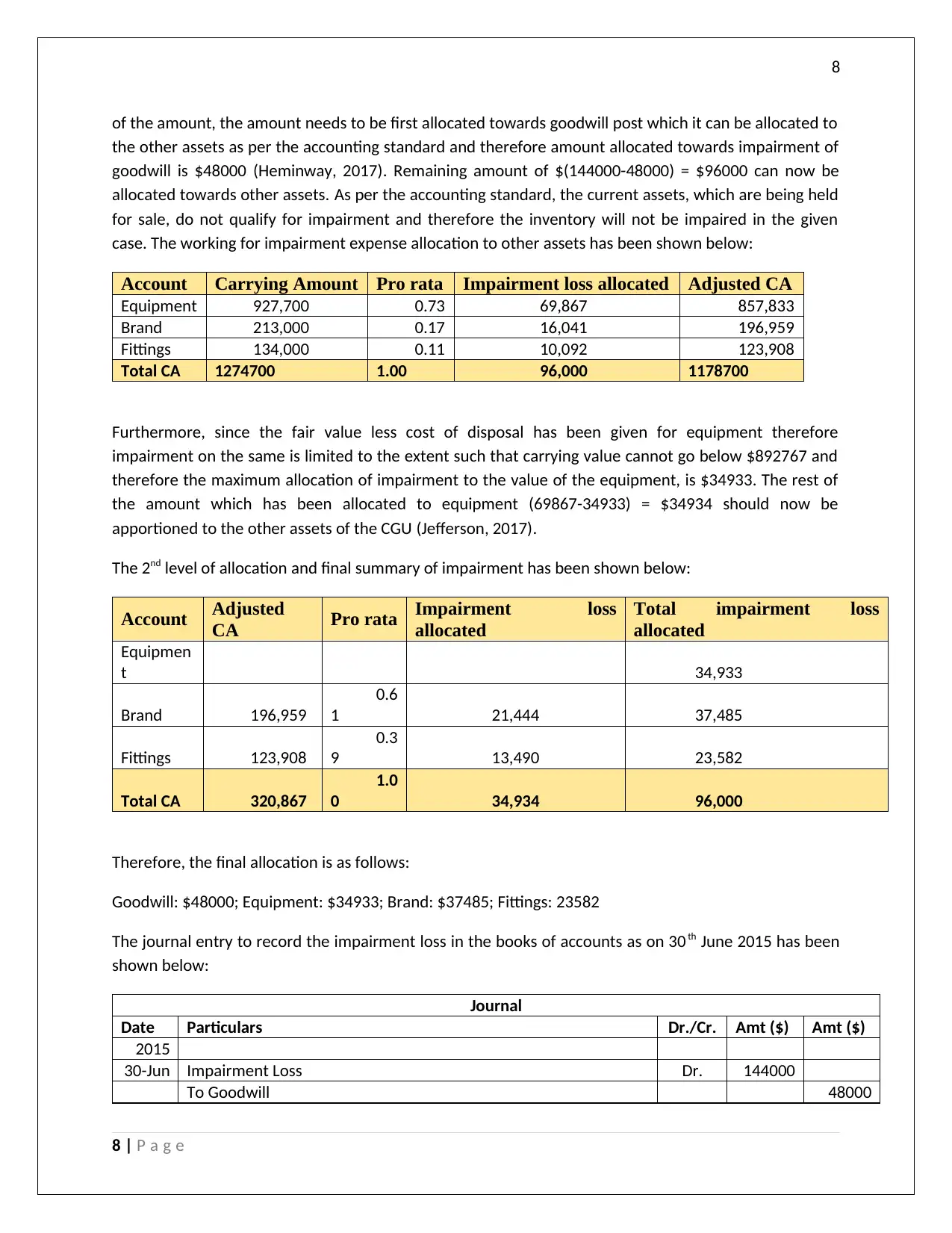
8
of the amount, the amount needs to be first allocated towards goodwill post which it can be allocated to
the other assets as per the accounting standard and therefore amount allocated towards impairment of
goodwill is $48000 (Heminway, 2017). Remaining amount of $(144000-48000) = $96000 can now be
allocated towards other assets. As per the accounting standard, the current assets, which are being held
for sale, do not qualify for impairment and therefore the inventory will not be impaired in the given
case. The working for impairment expense allocation to other assets has been shown below:
Account Carrying Amount Pro rata Impairment loss allocated Adjusted CA
Equipment 927,700 0.73 69,867 857,833
Brand 213,000 0.17 16,041 196,959
Fittings 134,000 0.11 10,092 123,908
Total CA 1274700 1.00 96,000 1178700
Furthermore, since the fair value less cost of disposal has been given for equipment therefore
impairment on the same is limited to the extent such that carrying value cannot go below $892767 and
therefore the maximum allocation of impairment to the value of the equipment, is $34933. The rest of
the amount which has been allocated to equipment (69867-34933) = $34934 should now be
apportioned to the other assets of the CGU (Jefferson, 2017).
The 2nd level of allocation and final summary of impairment has been shown below:
Account Adjusted
CA Pro rata Impairment loss
allocated
Total impairment loss
allocated
Equipmen
t 34,933
Brand 196,959
0.6
1 21,444 37,485
Fittings 123,908
0.3
9 13,490 23,582
Total CA 320,867
1.0
0 34,934 96,000
Therefore, the final allocation is as follows:
Goodwill: $48000; Equipment: $34933; Brand: $37485; Fittings: 23582
The journal entry to record the impairment loss in the books of accounts as on 30 th June 2015 has been
shown below:
Journal
Date Particulars Dr./Cr. Amt ($) Amt ($)
2015
30-Jun Impairment Loss Dr. 144000
To Goodwill 48000
8 | P a g e
of the amount, the amount needs to be first allocated towards goodwill post which it can be allocated to
the other assets as per the accounting standard and therefore amount allocated towards impairment of
goodwill is $48000 (Heminway, 2017). Remaining amount of $(144000-48000) = $96000 can now be
allocated towards other assets. As per the accounting standard, the current assets, which are being held
for sale, do not qualify for impairment and therefore the inventory will not be impaired in the given
case. The working for impairment expense allocation to other assets has been shown below:
Account Carrying Amount Pro rata Impairment loss allocated Adjusted CA
Equipment 927,700 0.73 69,867 857,833
Brand 213,000 0.17 16,041 196,959
Fittings 134,000 0.11 10,092 123,908
Total CA 1274700 1.00 96,000 1178700
Furthermore, since the fair value less cost of disposal has been given for equipment therefore
impairment on the same is limited to the extent such that carrying value cannot go below $892767 and
therefore the maximum allocation of impairment to the value of the equipment, is $34933. The rest of
the amount which has been allocated to equipment (69867-34933) = $34934 should now be
apportioned to the other assets of the CGU (Jefferson, 2017).
The 2nd level of allocation and final summary of impairment has been shown below:
Account Adjusted
CA Pro rata Impairment loss
allocated
Total impairment loss
allocated
Equipmen
t 34,933
Brand 196,959
0.6
1 21,444 37,485
Fittings 123,908
0.3
9 13,490 23,582
Total CA 320,867
1.0
0 34,934 96,000
Therefore, the final allocation is as follows:
Goodwill: $48000; Equipment: $34933; Brand: $37485; Fittings: 23582
The journal entry to record the impairment loss in the books of accounts as on 30 th June 2015 has been
shown below:
Journal
Date Particulars Dr./Cr. Amt ($) Amt ($)
2015
30-Jun Impairment Loss Dr. 144000
To Goodwill 48000
8 | P a g e
⊘ This is a preview!⊘
Do you want full access?
Subscribe today to unlock all pages.

Trusted by 1+ million students worldwide
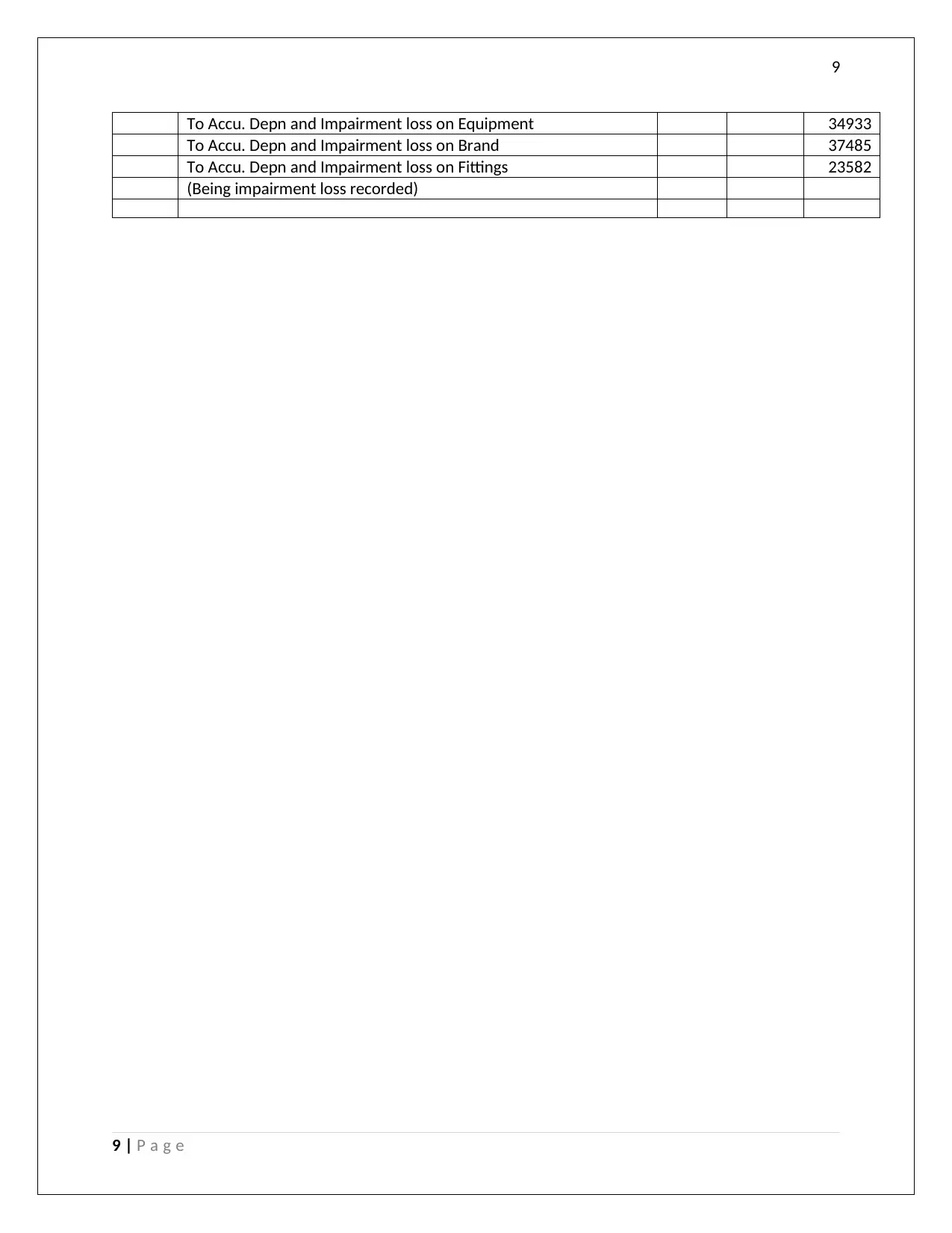
9
To Accu. Depn and Impairment loss on Equipment 34933
To Accu. Depn and Impairment loss on Brand 37485
To Accu. Depn and Impairment loss on Fittings 23582
(Being impairment loss recorded)
9 | P a g e
To Accu. Depn and Impairment loss on Equipment 34933
To Accu. Depn and Impairment loss on Brand 37485
To Accu. Depn and Impairment loss on Fittings 23582
(Being impairment loss recorded)
9 | P a g e
Paraphrase This Document
Need a fresh take? Get an instant paraphrase of this document with our AI Paraphraser
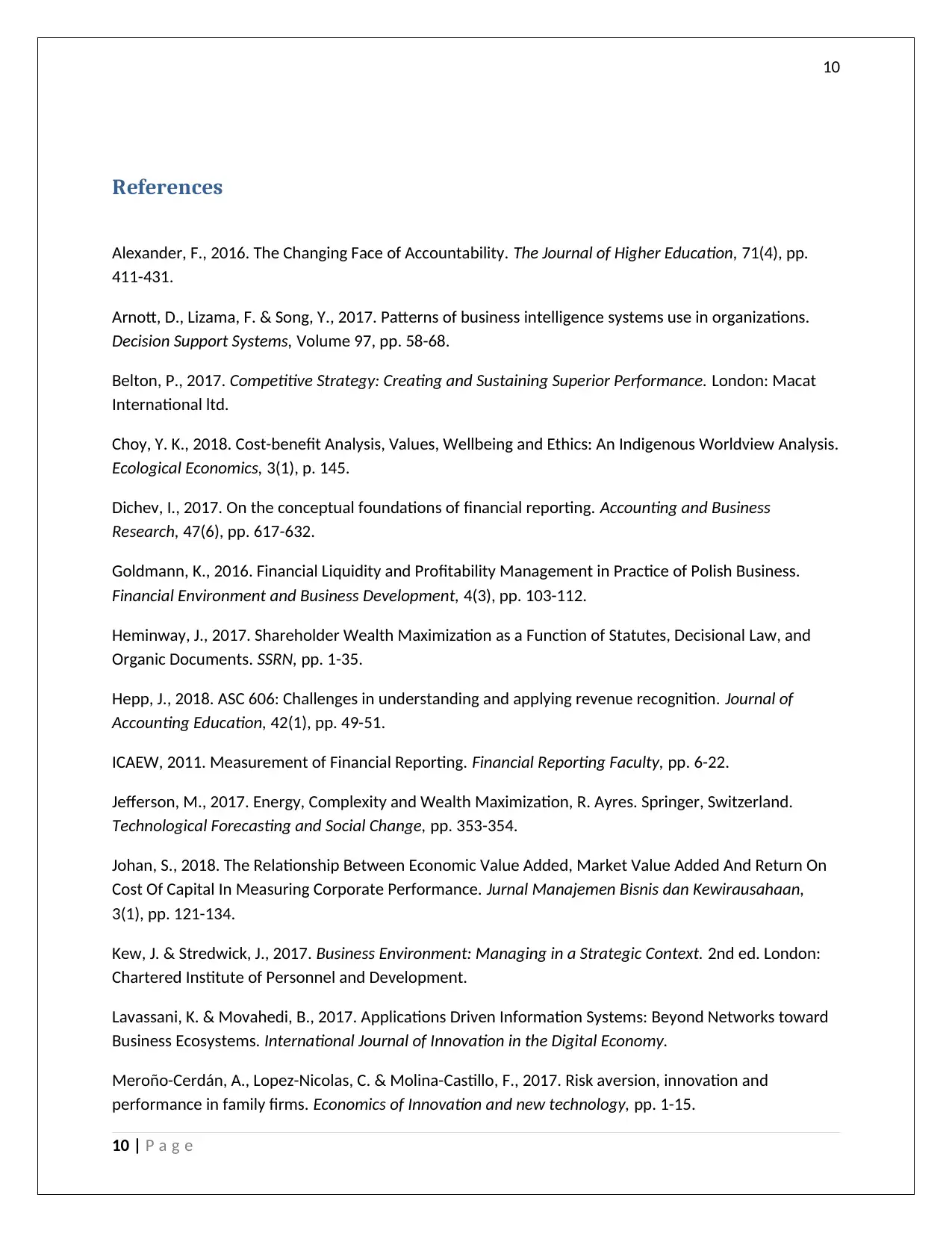
10
References
Alexander, F., 2016. The Changing Face of Accountability. The Journal of Higher Education, 71(4), pp.
411-431.
Arnott, D., Lizama, F. & Song, Y., 2017. Patterns of business intelligence systems use in organizations.
Decision Support Systems, Volume 97, pp. 58-68.
Belton, P., 2017. Competitive Strategy: Creating and Sustaining Superior Performance. London: Macat
International ltd.
Choy, Y. K., 2018. Cost-benefit Analysis, Values, Wellbeing and Ethics: An Indigenous Worldview Analysis.
Ecological Economics, 3(1), p. 145.
Dichev, I., 2017. On the conceptual foundations of financial reporting. Accounting and Business
Research, 47(6), pp. 617-632.
Goldmann, K., 2016. Financial Liquidity and Profitability Management in Practice of Polish Business.
Financial Environment and Business Development, 4(3), pp. 103-112.
Heminway, J., 2017. Shareholder Wealth Maximization as a Function of Statutes, Decisional Law, and
Organic Documents. SSRN, pp. 1-35.
Hepp, J., 2018. ASC 606: Challenges in understanding and applying revenue recognition. Journal of
Accounting Education, 42(1), pp. 49-51.
ICAEW, 2011. Measurement of Financial Reporting. Financial Reporting Faculty, pp. 6-22.
Jefferson, M., 2017. Energy, Complexity and Wealth Maximization, R. Ayres. Springer, Switzerland.
Technological Forecasting and Social Change, pp. 353-354.
Johan, S., 2018. The Relationship Between Economic Value Added, Market Value Added And Return On
Cost Of Capital In Measuring Corporate Performance. Jurnal Manajemen Bisnis dan Kewirausahaan,
3(1), pp. 121-134.
Kew, J. & Stredwick, J., 2017. Business Environment: Managing in a Strategic Context. 2nd ed. London:
Chartered Institute of Personnel and Development.
Lavassani, K. & Movahedi, B., 2017. Applications Driven Information Systems: Beyond Networks toward
Business Ecosystems. International Journal of Innovation in the Digital Economy.
Meroño-Cerdán, A., Lopez-Nicolas, C. & Molina-Castillo, F., 2017. Risk aversion, innovation and
performance in family firms. Economics of Innovation and new technology, pp. 1-15.
10 | P a g e
References
Alexander, F., 2016. The Changing Face of Accountability. The Journal of Higher Education, 71(4), pp.
411-431.
Arnott, D., Lizama, F. & Song, Y., 2017. Patterns of business intelligence systems use in organizations.
Decision Support Systems, Volume 97, pp. 58-68.
Belton, P., 2017. Competitive Strategy: Creating and Sustaining Superior Performance. London: Macat
International ltd.
Choy, Y. K., 2018. Cost-benefit Analysis, Values, Wellbeing and Ethics: An Indigenous Worldview Analysis.
Ecological Economics, 3(1), p. 145.
Dichev, I., 2017. On the conceptual foundations of financial reporting. Accounting and Business
Research, 47(6), pp. 617-632.
Goldmann, K., 2016. Financial Liquidity and Profitability Management in Practice of Polish Business.
Financial Environment and Business Development, 4(3), pp. 103-112.
Heminway, J., 2017. Shareholder Wealth Maximization as a Function of Statutes, Decisional Law, and
Organic Documents. SSRN, pp. 1-35.
Hepp, J., 2018. ASC 606: Challenges in understanding and applying revenue recognition. Journal of
Accounting Education, 42(1), pp. 49-51.
ICAEW, 2011. Measurement of Financial Reporting. Financial Reporting Faculty, pp. 6-22.
Jefferson, M., 2017. Energy, Complexity and Wealth Maximization, R. Ayres. Springer, Switzerland.
Technological Forecasting and Social Change, pp. 353-354.
Johan, S., 2018. The Relationship Between Economic Value Added, Market Value Added And Return On
Cost Of Capital In Measuring Corporate Performance. Jurnal Manajemen Bisnis dan Kewirausahaan,
3(1), pp. 121-134.
Kew, J. & Stredwick, J., 2017. Business Environment: Managing in a Strategic Context. 2nd ed. London:
Chartered Institute of Personnel and Development.
Lavassani, K. & Movahedi, B., 2017. Applications Driven Information Systems: Beyond Networks toward
Business Ecosystems. International Journal of Innovation in the Digital Economy.
Meroño-Cerdán, A., Lopez-Nicolas, C. & Molina-Castillo, F., 2017. Risk aversion, innovation and
performance in family firms. Economics of Innovation and new technology, pp. 1-15.
10 | P a g e
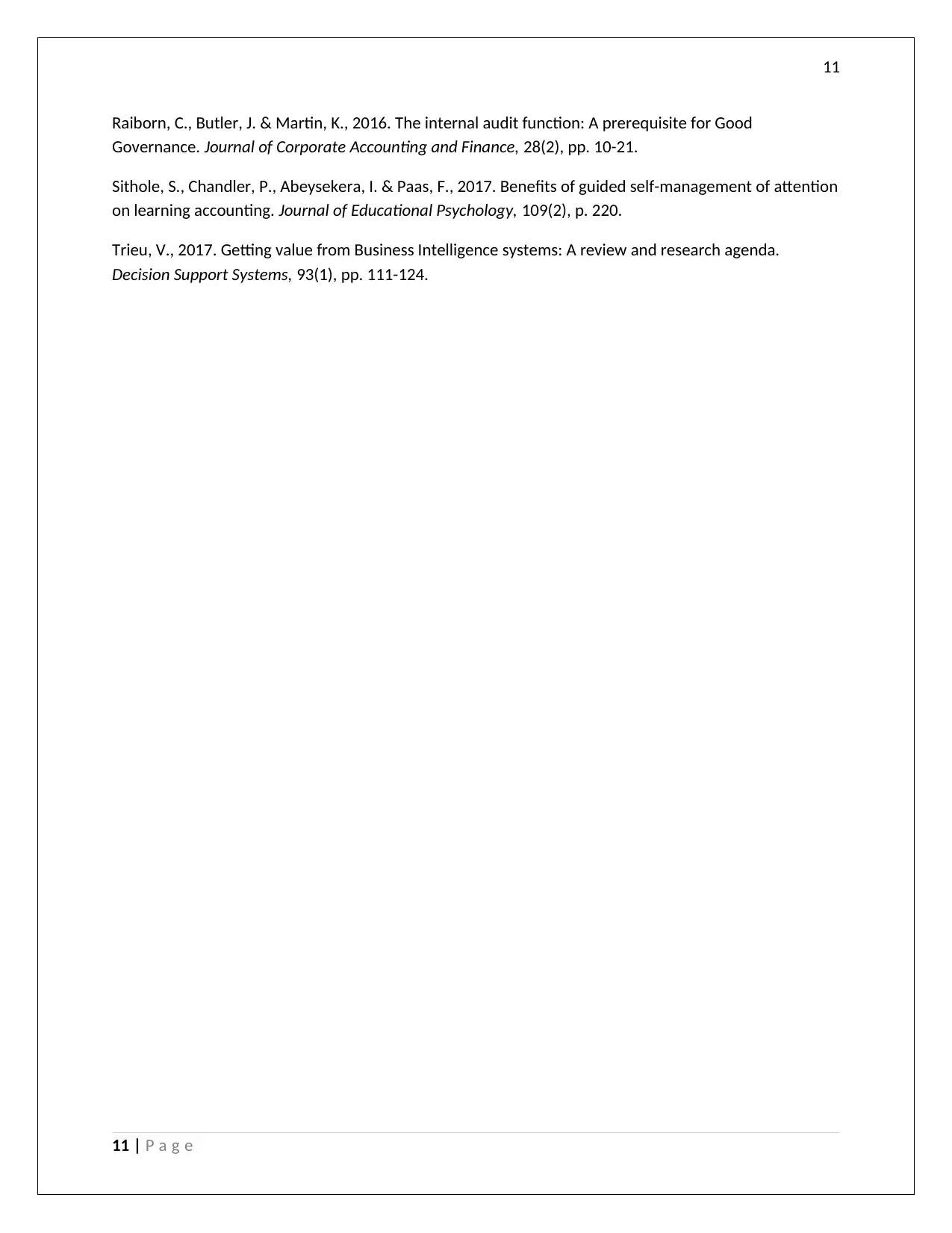
11
Raiborn, C., Butler, J. & Martin, K., 2016. The internal audit function: A prerequisite for Good
Governance. Journal of Corporate Accounting and Finance, 28(2), pp. 10-21.
Sithole, S., Chandler, P., Abeysekera, I. & Paas, F., 2017. Benefits of guided self-management of attention
on learning accounting. Journal of Educational Psychology, 109(2), p. 220.
Trieu, V., 2017. Getting value from Business Intelligence systems: A review and research agenda.
Decision Support Systems, 93(1), pp. 111-124.
11 | P a g e
Raiborn, C., Butler, J. & Martin, K., 2016. The internal audit function: A prerequisite for Good
Governance. Journal of Corporate Accounting and Finance, 28(2), pp. 10-21.
Sithole, S., Chandler, P., Abeysekera, I. & Paas, F., 2017. Benefits of guided self-management of attention
on learning accounting. Journal of Educational Psychology, 109(2), p. 220.
Trieu, V., 2017. Getting value from Business Intelligence systems: A review and research agenda.
Decision Support Systems, 93(1), pp. 111-124.
11 | P a g e
⊘ This is a preview!⊘
Do you want full access?
Subscribe today to unlock all pages.

Trusted by 1+ million students worldwide
1 out of 12
Related Documents
Your All-in-One AI-Powered Toolkit for Academic Success.
+13062052269
info@desklib.com
Available 24*7 on WhatsApp / Email
![[object Object]](/_next/static/media/star-bottom.7253800d.svg)
Unlock your academic potential
Copyright © 2020–2025 A2Z Services. All Rights Reserved. Developed and managed by ZUCOL.





